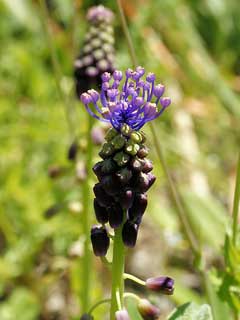 |
|
http://commons.wikimedia.org/wiki/User:Lycaon |
 |
| http://commons.wikimedia.org/wiki/User:Lycaon |
Translate this page:
Summary
Physical Characteristics

 Muscari comosum is a BULB growing to 0.5 m (1ft 8in) by 0.1 m (0ft 4in).
Muscari comosum is a BULB growing to 0.5 m (1ft 8in) by 0.1 m (0ft 4in).
See above for USDA hardiness. It is hardy to UK zone 4 and is not frost tender. It is in flower from May to July, and the seeds ripen in August. The species is hermaphrodite (has both male and female organs) and is pollinated by Insects. The plant is self-fertile.
Suitable for: light (sandy), medium (loamy) and heavy (clay) soils and prefers well-drained soil. Suitable pH: mildly acid, neutral and basic (mildly alkaline) soils. It can grow in semi-shade (light woodland) or no shade. It prefers dry or moist soil.
UK Hardiness Map
US Hardiness Map
Synonyms
Hyacinthus comosum. Leopoldia comosa.
Plant Habitats
Woodland Garden Sunny Edge; Dappled Shade; Shady Edge; Lawn; Hedgerow;
Edible Uses
Edible Parts: Root
Edible Uses:
Bulb - cooked[22, 61, 183]. It is about 35mm in diameter[200]. A slightly bitter taste[7] that is appreciated by certain ethnic groups, especially Greeks and Italians[183]. Used in spring[46, 177]. The cooked bulbs, preserved in oil, are used as a relish[183].
References More on Edible Uses
Medicinal Uses
Plants For A Future can not take any responsibility for any adverse effects from the use of plants. Always seek advice from a professional before using a plant medicinally.
Appetizer Diuretic Poultice
The bulb is appetizer and diuretic[7, 183]. The bulb is rich in mucilage and can be crushed then applied as a poultice to reddened skin[7].
References More on Medicinal Uses
The Bookshop: Edible Plant Books
Our Latest books on Perennial Plants For Food Forests and Permaculture Gardens in paperback or digital formats.

Edible Tropical Plants
Food Forest Plants for Hotter Conditions: 250+ Plants For Tropical Food Forests & Permaculture Gardens.
More

Edible Temperate Plants
Plants for Your Food Forest: 500 Plants for Temperate Food Forests & Permaculture Gardens.
More

More Books
PFAF have eight books available in paperback and digital formats. Browse the shop for more information.
Shop Now
Other Uses
References More on Other Uses
Cultivation details
Prefers a rich open well-drained soil[1]. Succeeds in any soil and situation[1, 42]. Does very well in short grass[1], increasing freely and it can become invasive[200]. The flowers have a pleasing perfume[245]. There is at least one named form, selected for its ornamental value[200].
References Carbon Farming Information and Carbon Sequestration Information
Temperature Converter
Type a value in the Celsius field to convert the value to Fahrenheit:
Fahrenheit:
The PFAF Bookshop
Plants For A Future have a number of books available in paperback and digital form. Book titles include Edible Plants, Edible Perennials, Edible Trees,Edible Shrubs, Woodland Gardening, and Temperate Food Forest Plants. Our new book is Food Forest Plants For Hotter Conditions (Tropical and Sub-Tropical).
Shop Now
Plant Propagation
Seed - best sown as soon as ripe in a greenhouse[200]. The seed can also be sown in early spring in a greenhouse. A good proportion of the seed usually germinates within 2 - 3 months. Sow the seed thinly so that the seedlings can be left undisturbed in the pot for their first year of growth. Give them an occasional liquid feed in the growing season to ensure they do not become nutrient deficient. When the plants become dormant in late summer, pot up the small bulbs placing 2 - 3 bulbs in each pot. Grow them on for another one or two years in the greenhouse before planting them out when they are dormant in late summer. If you have sufficient seed then it is worthwhile trying sowing it in situ outdoors in early spring. This is rather a hit and miss method, but a lot less work than indoor sowing. Division of offsets in July/August after the leaves die down[1]. It can be done every other year if a quick increase is required[1]. Larger bulbs can be replanted direct into their permanent positions, but it is best to pot up the smaller bulbs and grow them on in a cold frame for a year before planting them out when they are dormant in late summer.
Other Names
If available other names are mentioned here
Native Range
TEMPERATE ASIA: Cyprus, Iran, Iraq, Israel, Jordan, Lebanon, Syria, Turkey EUROPE: Czechoslovakia, Austria, Switzerland, Germany, Hungary, Poland, Ukraine (incl. Krym), Former Yugoslavia, Albania, Bulgaria, Greece (incl. Crete), Italy (incl. Sardinia, Sicily), Romania, Spain (incl. Baleares), France (incl. Corsica), Portugal AFRICA: Algeria, Egypt, Libya, Morocco, Tunisia
Weed Potential
Right plant wrong place. We are currently updating this section.
Please note that a plant may be invasive in one area but may not in your area so it's worth checking.
Conservation Status
IUCN Red List of Threatened Plants Status :

Growth: S = slow M = medium F = fast. Soil: L = light (sandy) M = medium H = heavy (clay). pH: A = acid N = neutral B = basic (alkaline). Shade: F = full shade S = semi-shade N = no shade. Moisture: D = dry M = Moist We = wet Wa = water.
Now available:
Food Forest Plants for Mediterranean Conditions
350+ Perennial Plants For Mediterranean and Drier Food Forests and Permaculture Gardens.
[Paperback and eBook]
This is the third in Plants For A Future's series of plant guides for food forests tailored to
specific climate zones. Following volumes on temperate and tropical ecosystems, this book focuses
on species suited to Mediterranean conditions—regions with hot, dry summers and cool, wet winters,
often facing the added challenge of climate change.
Read More
Expert comment
Author
(L.)Mill.
Botanical References
50200
Links / References
For a list of references used on this page please go here
Readers comment